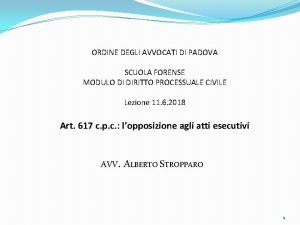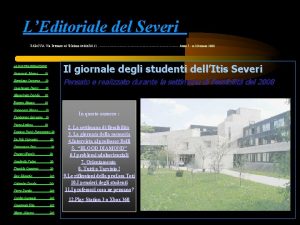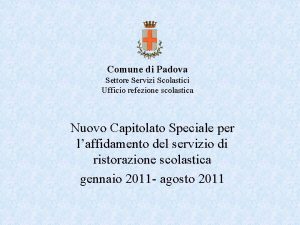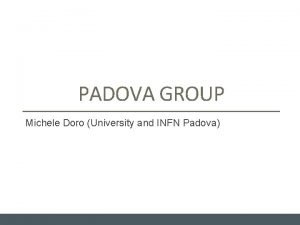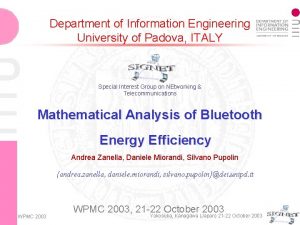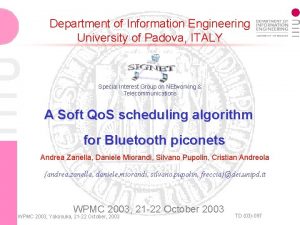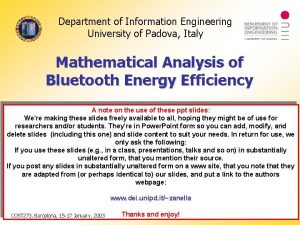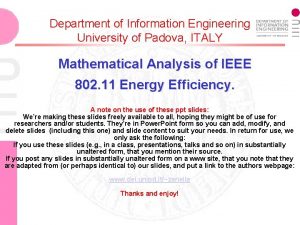University of Padova Department of Information Engineering On












- Slides: 12

University of Padova Department of Information Engineering On the Optimal Topology of Bluetooth Piconets: Roles Swapping Algorithms Daniele Miorandi & Andrea Zanella {daniele. miorandi, andrea. zanella}@dei. unipd. it Med-Hoc-Net 2002 , Chia (Italy), 6 September 2002

Overview ØProblem definition: find efficient topologies for Bluetooth networks. ØFirst step: study of optimal piconet configurations. ØAssumption: knowledge of the end-to-end traffic matrix. ØStability issues & delay analysis (with Pure Round Robin and Poisson traffic). ØMetrics: average packet delay. ØOptimal criterion for off-line topologies design. ØSuboptimal criterion (lower computational complexity) for real-time network reconfiguration. ØConclusion & discussion. D. Miorandi & A. Zanella Med-Hoc-Net, Chia, 6 September 2002

Background: BT system architecture ØPiconet üTwo up to eight active Bluetooth devices sharing the same FH channel form a piconet. üIn each piconet, a unit acts as a master, the others act as slaves. üChannel access is based on a centralized polling scheme. üFull duplex is achieved by means of time division duplexing (TDD). ØScatternet: üPiconets may overlap and may be connected by means of a shared inter-piconet units (IPUs). üIPUs may be shared on a time-division basis, which may be realized using low-power SNIFF mode. D. Miorandi & A. Zanella slave 2 slave 3 master slave 1 master active slave parked slave standby Med-Hoc-Net, Chia, 6 September 2002

System Model ØCluster of (N+1) nodes ( ). ØAssumptions: ØEach node is in the coverage area of all other nodes; ØThe traffic flows may be modeled as independent Poisson processes. ØEnd-to-end traffic matrix (average packets generation rates). ØPiconet definition: ØEffective traffic pattern matrix (traffic actually flowing on the net): D. Miorandi & A. Zanella Med-Hoc-Net, Chia, 6 September 2002

System Model (2) ØStability condition for the PRR polling scheme: ØDefinition: A traffic matrix is admissible if there is a master choice k s. t. the stability condition holds (i. e. there is a stable topology). ØDefinition: A traffic matrix is fully admissible if the stability conditions hold for any choice of the master k. ØProposition: A traffic matrix following conditions hold: is fully admissible if and only if the ØProposition: A traffic matrix following conditions hold: is admissible if and only if the D. Miorandi & A. Zanella Med-Hoc-Net, Chia, 6 September 2002

Optimal Criterion ØLink delay: ØUp to a randomization of the polling order the average packet delay may be expressed as: ØDefining as the total offered traffic we have: ØCriterion I: choose k s. t. D. Miorandi & A. Zanella Med-Hoc-Net, Chia, 6 September 2002

Suboptimal Criterion ØThe effective offered traffic is given by: ØReasoning: üThe more the effective traffic, the closer we get to the stability limit. üThe closer to the stability limit, the higher the delay. ØCriterion II: choose k s. t. D. Miorandi & A. Zanella Med-Hoc-Net, Chia, 6 September 2002

Results (1) ØAt medium-to-high loads, both criterion offer a remarkable performance improvement. ØThe suboptimal criterion leads to results good, even if far from optimality. N=5, matrix entries uniformly distributed in (0, 1). D. Miorandi & A. Zanella Med-Hoc-Net, Chia, 6 September 2002

Results (2) ØThe delays are much lower in the sparse case. ØBoth criterion offer valuable performance improvement. N=5, matrix entries uniformly distributed in (0, 1), average density of 0. 4. D. Miorandi & A. Zanella Med-Hoc-Net, Chia, 6 September 2002

Applications ØOptimal design of a static Bluetooth piconet (e. g. , sensor networks). ØDynamic reconfiguration of a Bluetooth piconet: üEach node keeps an estimate of the traffic generated towards the other nodes. üThe suboptimal criterion is used to find “better” configurations. üConnection admission control: for each request the master checks for admissibility of the resulting traffic matrix; if the answer is negative the request is dropped. D. Miorandi & A. Zanella Med-Hoc-Net, Chia, 6 September 2002

Conclusion ØAn analytical settlement for the characterization of efficient piconet topologies has been proposed. ØTwo algorithms for the master choice (an optimal and a suboptimal with low computational complexity) have been presented. ØSimulation have been performed to show the impact on network performance. ØSome applications have been presented. ØNext step: towards efficient scatternet topologies. D. Miorandi & A. Zanella Med-Hoc-Net, Chia, 6 September 2002

Any Questions? D. Miorandi & A. Zanella Med-Hoc-Net, Chia, 6 September 2002
 Department of information engineering university of padova
Department of information engineering university of padova Department of information engineering university of padova
Department of information engineering university of padova Mechanicistic
Mechanicistic Information engineering padova
Information engineering padova University of sargodha engineering department
University of sargodha engineering department Scuola primaria mantegna padova
Scuola primaria mantegna padova Organigramma comune di padova
Organigramma comune di padova Scuola forense padova
Scuola forense padova Via pettinati 46 padova
Via pettinati 46 padova Introduzione al vangelo di luca
Introduzione al vangelo di luca Istituto comprensivo forte dei marmi
Istituto comprensivo forte dei marmi Iniziazione cristiana padova
Iniziazione cristiana padova Servizi scolastici padova
Servizi scolastici padova







